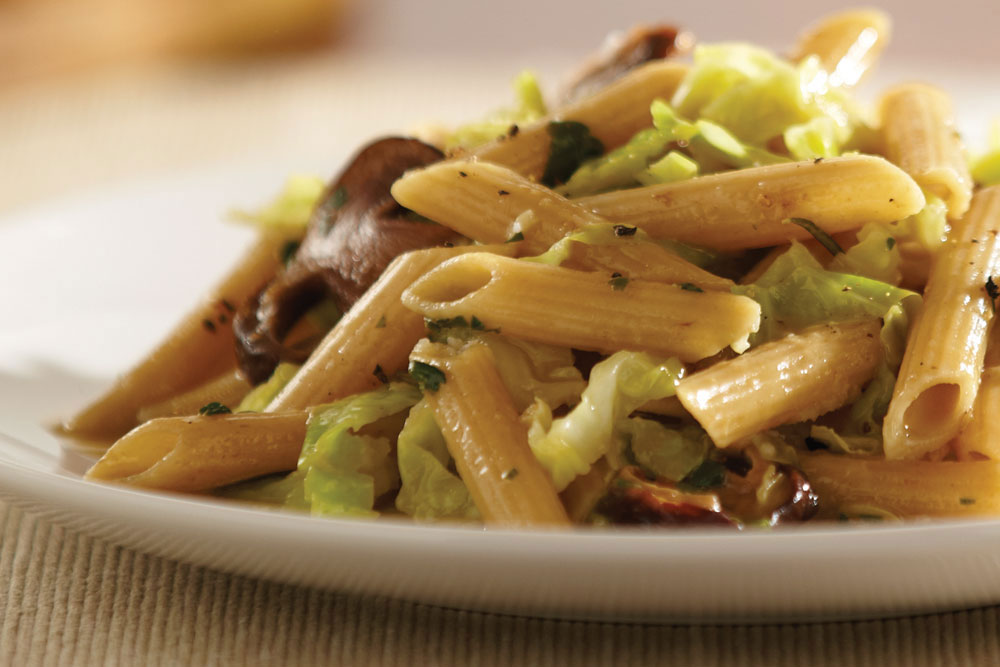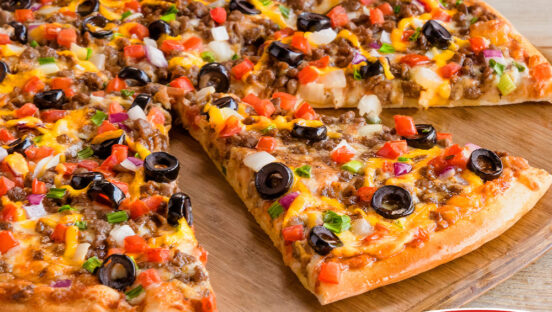It’s hard to imagine, but not everyone loves pizza. And even the most ardent pizza lover gets a little burned out on it now and then. That’s why pasta should be considered for most pizzeria menus. From spaghetti to lasagna, from linguine to rigatoni, pasta is more than just a quintessential comfort food—it’s the starting point for countless dishes, from kid-pleasing mac and cheese to high-dollar specialty entrees such as veal tortellini and baked ravioli Bolognese.
Americans love pasta nearly as much as Italians do, according to Phil Casamento, owner of Utica, New York-based Casa Imports. “Per capita consumption of pasta in the United States is second in the world, behind Italy. It’s also a very profitable item, more profitable than pizza. A full serving will cost only about $1, but it can be sold for $8.99 or $9.99. And it’s a relatively easy item to produce. A few options of cuts and sauces can yield a lot of customer choice.”
And customer choice is what it’s all about. “We’ve discovered that we’ll get a group of folks in and sell nine slices of pizza and one pasta dish. However, they would not have come in if that pasta dish wasn’t available,” says Rick Glenn, president of the Salem, Oregon-based Pizza Schmizza (schmizza.com) chain. “Out of a group of potential diners, everyone has veto power in terms of where they go. So we offer some options besides pizza, and it gets us that last vote.”
| Pasta Perfection |
|
When it comes to pasta, no one can out-eat the Italians. According to the National Pasta Association, the average Italian scarfs down more than 51 pounds of pasta per year. The average American eats far less—just under 20 pounds annually—but pasta is still a very popular (and highly profitable) menu item for pizzerias. And since spaghetti is the most popular pasta shape in the United States, here are a couple of recipes (provided by Barilla) to get you started:
Spaghetti CarbonaraYou’ll Need:
Preparation:Cook the pasta for half the time indicated on the package. Drain the pasta and drizzle with some olive oil to prevent sticking. Place pasta flat on sheet trays or hotel pans and cool in a blast chiller or a walk-in cooler. Store in ziplock bags or a sealed plastic container; refrigerate and use within several hours. For each serving, bring 1 c. cream and 1 tsp. guanciale fat to a simmer and stir in 2 oz. cheese. Reheat 2 2/3 cups pasta in simmering water. Drain and add to the cream. Stir to heat through. Plate the pasta and top it with 1½ oz. guanciale, 1 egg yolk cracked on top and a sprinkling of black pepper. Garnish with 1 oz. cheese. Yields 24 servings.
Thick Spaghetti with Eggplant, Cherry Tomatoes and Ricotta Salata SauceYou’ll Need:
Preparation:Cook the pasta for half the time indicated on the package; drain, store and cool. Season the eggplant with sea salt. Transfer to colanders or drip pans and place weights on top. Allow to drain for 1 hour. Rinse excess salt from from the eggplant. Sweat the onions and pepper flakes in oil until translucent. Toss the eggplant with flour and add to the onions. Cook until falling apart. Remove from heat. Season with salt and pepper. (You can cook to this point and reheat later for service.) For each serving, blister 1¼ oz. tomatoes in a little oil over high heat for 2 minutes. Season with salt and pepper. Reduce heat to low, add ½ c. eggplant sauce and heat until warm. Reheat 1 c. spaghetti in boiling salted water for 40 to 60 seconds. Drain and add it to the sauce. Add up to ¼ c. pasta water to reach the desired sauce consistency. Finish the pasta with ¾ oz. cheese and a drizzle of oil. Garnish with 1 basil leaf, torn into pieces. Yields 24 servings. |
Executive chef Micah Windham from Pele’s Wood Fire Pizza (peleswoodfire.com), an upscale Italian-American restaurant in Jacksonville, Florida, agrees. Pele’s offers a variety of seasonal pasta dishes for a more well-rounded menu. “As a restaurant, it’s important to cater to the whole body every day of the week. The market tells us that there are some days when people crave something light and simple and other days when they want something slow-cooked and hearty.”
With hundreds of types of pasta and a vast array of sauces and toppings, chefs can stick with time-honored recipes or venture out on a creative limb—they’re limited only by their imaginations. “The tried-and-true preparations are always in demand and can be successfully sold if they’re prepared in ways that address the primary elements of cooking and eating—taste, texture, portion size, temperature and presentation,” says chef John Terczak, host of The Seasoned Cook, an online culinary course offered on YouTube, and owner of The Kitchen at the Creek in Evergreen, Colorado. “But operators should always keep their concept and market in mind. They should be careful about straying too far from what their customers’ expectations might be.”
In the Beginning
For pizzeria operators looking to introduce pasta dishes to their menus, Terczak says utilizing products that are already on hand is a cost-effective way to start. “A good example of a dish that an operator might be able to create without buying new products would be a pasta that features tomato sauce, sausage, pepperoni, olive oil, basil, mushrooms, green peppers and Parmesan cheese. This incorporates pizza flavors without the crust. Adding soft or crispy breadsticks as a garnish to the dish might satisfy the texture requirements of the pizza lover without the operator having to expand inventory.”
Meanwhile, nontraditional pasta dishes allow the chef to indulge his creative side. The Cajunator at Pizza Schmizza features alligator sausage, a delicacy rarely found on menus outside of southern Louisiana, tossed in a light Cajun chipotle cream sauce. “Early on, our founder tried several exotic meats as a way of differentiating Pizza Schmizza from everyone else. The gator stuck,” Glenn says. “My theory is that it doesn’t look so scary, and it’s fun to eat something that might eat you if the situation were different.” Less adventurous diners can choose a version of the Cajunator made with grilled chicken.
Windham is a farm-to-table cook, so Pele’s pasta offerings change with the seasons throughout the year. After he chooses his local ingredients, Windham picks the style of pasta that fits the topping and the season. He then decides on a cooking technique—baked, brothy, tomato-based, olive oil and garlic, slow-cooked ragu or creamy. “After a comparison of striking seasonal ingredients and a selection of pasta and technique, we have our base dishes; now we just have to top them. Fresh herbs are a must but should reflect what was used in the dish. Cheese is great but really not necessary on all pastas. I find extra-virgin olive oil or infused oils are a great partner to all pastas.”
The family-oriented Esposito’s Pizza and Pasta (espositopizza.com) in Matawan, New Jersey, serves pasta dishes from the traditional to the creative. Owner James Esposito’s young daughter, Isabella, inspired one of the menu’s most popular selections in a bid to get her to eat broccoli. “Our Pasta Bella consists of chicken breast and broccoli sautéed with fresh hand-crushed plum tomato and white wine, finished with freshly grated pecorino Romano and served with rigatoni, which holds the sauce in its ridges,” Esposito says. “As far as other pasta dishes, we sell a ton. Bolognese and Sunday sauces are two of our best-sellers.” The Bolognese is a traditional meat sauce with a touch of heavy cream, and the Sunday sauce is cooked low and slow for hours using pork shoulder as the base; it’s served with angel hair pasta, homemade pork and beef meatballs and a sausage link.
—Rob Persaud, vice president of marketing and innovation, American Italian Pasta Company
Into the Mix
Once you’ve decided to add pasta to your menu—or expand your current pasta selection—the next task is to incorporate it smoothly into your inventory and operational methods. Upscale pizza and pasta restaurants often choose to make their own pasta, an approach that certainly has its marketing advantages, while other operators use dried pasta for cost and convenience. Windham makes his own pasta, for example, while Esposito uses high-quality dried pasta imported from Italy. “I see dried pasta as preferable to fresh for both operators and customers,” Terczak notes. “It can be par-cooked and stored for a longer period of time without taking on any mushiness. Although fresh pasta is good and very satisfying, it can never replace the built-in value of dried pasta for storage and economics.”
For additional time and labor savings, preprepared ingredients can be used to create homestyle pasta dishes, Terczak adds. “Dressing them up is often the only choice for some operators,” he says. “If they’re starting out with a good and tasty product to begin with, beefing it up can be a very successful approach. Frozen meatballs can be dressed up in a tuxedo if the operator knows how to do it with the right sauce. If you take a mediocre canned tomato sauce and add extra-virgin olive oil, fresh or dried oregano or basil, along with seasonings, onions, wine, cream or bacon, you may end up with a great tomato sauce, regardless of what you started out with. Finally, when making a completely mixed pasta dish, I place something on top of it for garnish—such as grilled sliced chicken, tomato concassé, cheese, shrimp and herbs—to bring a two-part dimension to the eating experience.
 |
|
This whole-grain penne dish, made with cabbage, porcini mushrooms and shaved raschera cheese, represents typical northern Italian cuisine. |
Marketing Pasta
By promoting your pasta selection, you can introduce a new element to your customers’ dining experience and increase repeat business by bringing in those customers who simply don’t always want pizza. “We do not market the pasta as strongly as pizza in terms of media,” Glenn notes. “However, in the pizzeria, you’ll find pasta represented very well. Our servers do recommend or mention pasta. Often, we have promotional materials or samples in our pizza window.”
Esposito also makes sure his customers know about his pasta selection before they order. “Our servers ask tableside if the guest has any questions about any of our signature pasta dishes.”
The employees at Pele’s push their pasta more aggressively; they present it as an opportunity for their guests to experience an authentic multicourse Italian meal. “We like to give our servers as much information as possible to market the day’s selection and any specials that we might be running,” Windham says. “Our menu, website and social media do a phenomenal job of luring taste buds as well. We typically recommend a shared-style dining experience. For instance, an appetizer or fresh salad comes out first, house-made pasta comes out second, an artisan pizza comes out third, and, to finish, spun gelato for dessert. It’s a great meal for two.”
Meanwhile, if your restaurant caters to a family clientele, don’t forget the basics for kids. Mom and Dad may come in looking for a fancy Bolognese or a rich, creamy carbonara, but offer their tyke a heaping helping of spaghetti and meatballs, and you may have earned a customer for life!
Pasta Suppliers
American Italian Pasta Company, 877-EAT-PASTA, aipc.com
Barilla, 800-922-7455, barilla.com
Bellissimo Foods, 800-813-2974, bellissimofoods.com
Caesar’s Pasta, 888-432-2372, caesarspasta.com
Carso’s Pasta Company, 425-670-1302, carsospasta.com
Divine Pasta, 818-559-7440, divinepasta.com
Severino Pasta Company, 856-854-7666, severinopasta.com















